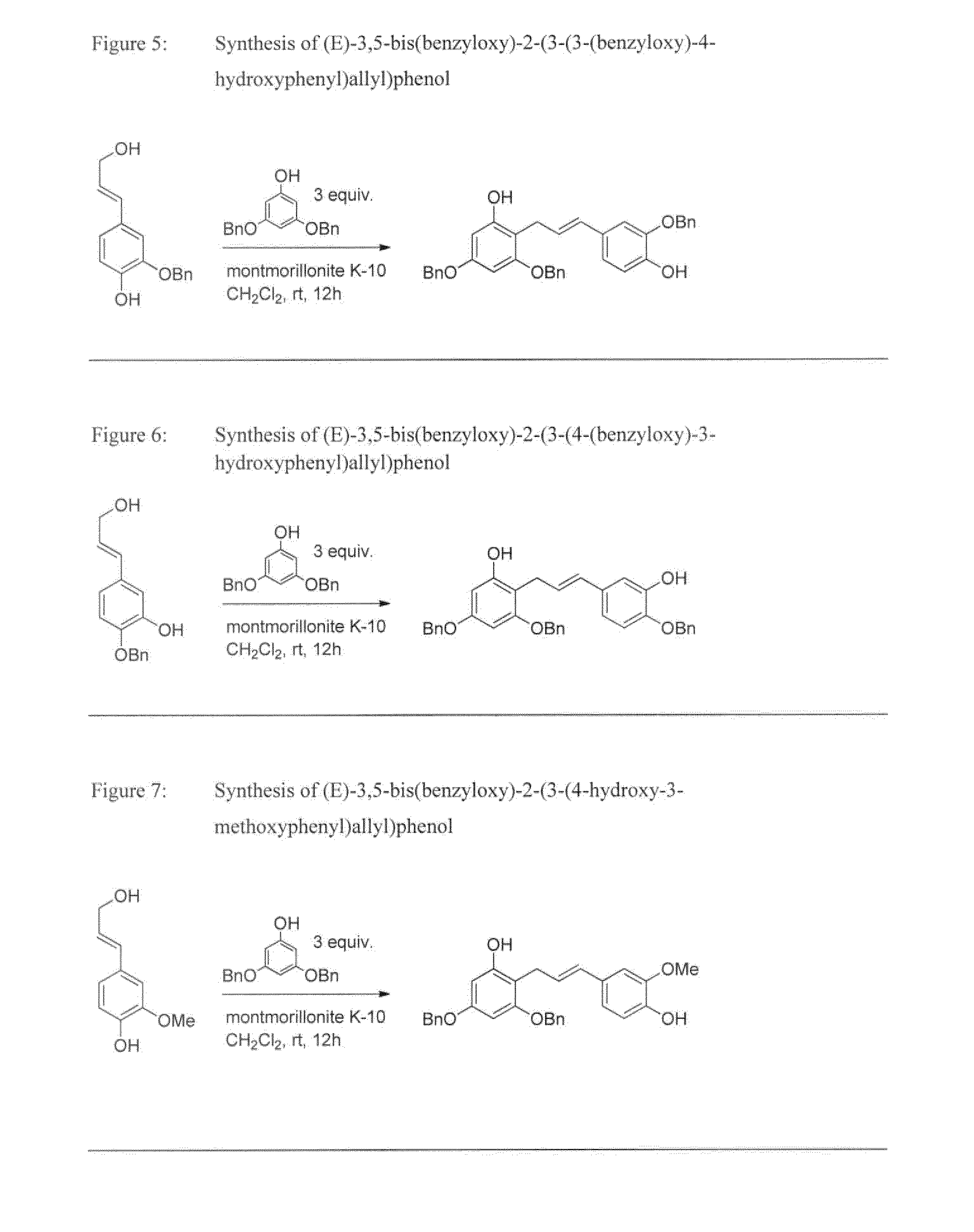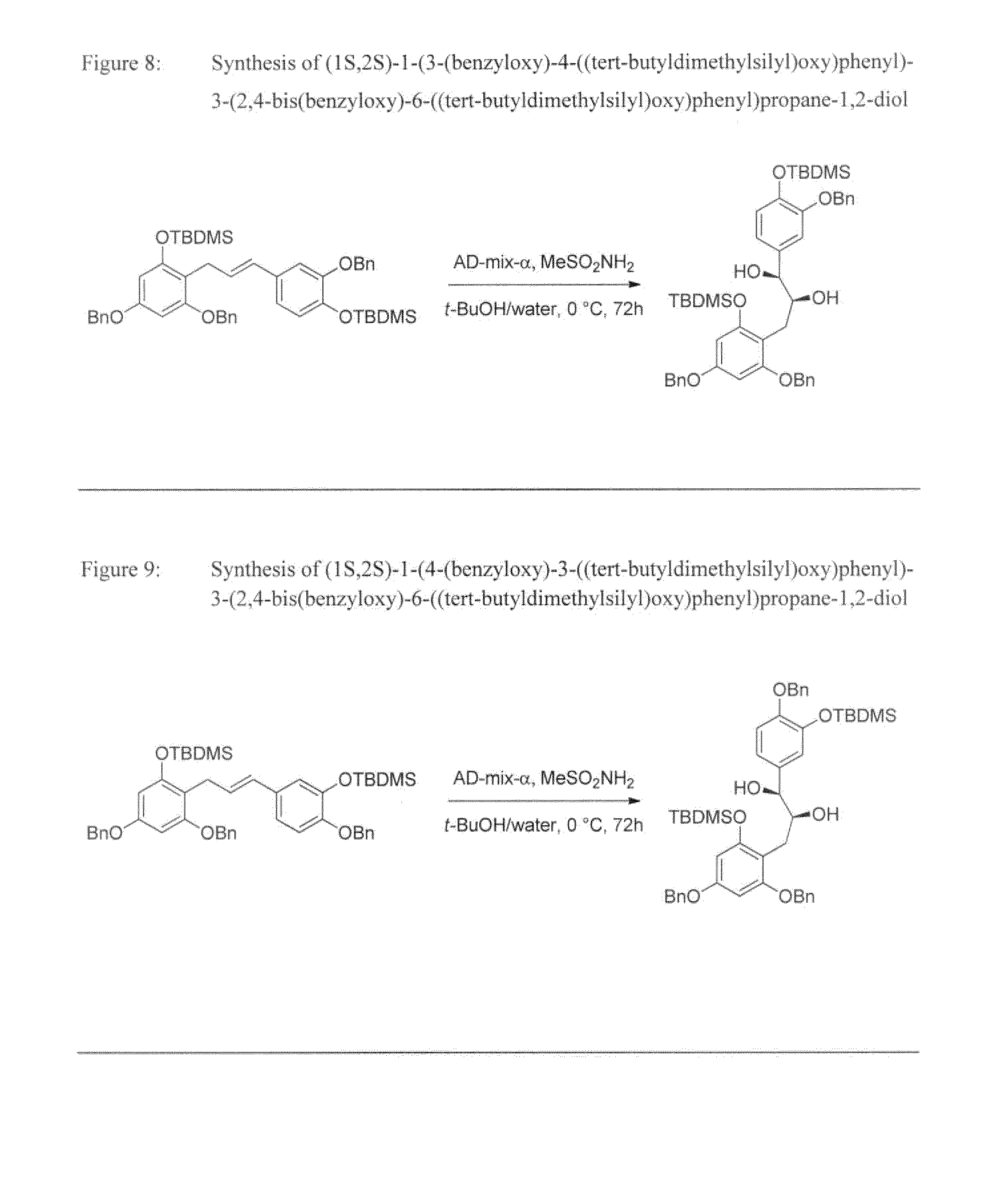Synthesis of catechin and epicatechin conjugates
a technology which is applied in the field of synthesis of catechin and epicatechin conjugates, can solve the problems of inversely associated with the risk of coronary heart disease, reduced atherosclerosis plaques, and immunodysfunction, and little data exists concerning catechin and epi-catechin metabolites
- Summary
- Abstract
- Description
- Claims
- Application Information
AI Technical Summary
Benefits of technology
Problems solved by technology
Method used
Image
Examples
example 1
Synthesis of Isomerically Pure Cinnamyl Alcohols
example 1a
Synthesis of (E)-2-(benzyloxy)-4-(3-hydroxyprop-1-en-1-yl)phenol
[0049]The synthesis of the title compound is illustrated on FIG. 1.
(E)-ethyl 3-(3-benzyloxy-4-hydroxyphenyl)acrylate
[0050]The E-selective Wittig olefination reaction was performed inside a flame-dried 100 mL two-necked round-bottomed flask, equipped with a magnetic stirrer bar and capped with a rubber septum, according to an experimental procedure adapted from the works of Georg et al. (J. Org. Chem. 2001, 66 (24), 8211-8214) and Couladouros et al. (Chem. Eur. J. 1998, 4 (1), 33-43). Accordingly, purified (isomerically pure) 3-benzyloxy-4-hydroxybenzaldehyde (1.87 g, 8.19 mmol, 1.0 equiv.) was dissolved in a 1:1 binary mixture of anhydrous tetrahydrofuran (15 mL) and anhydrous methylene chloride (15 mL). The required phosphorus ylide (ethyl (triphenylphosphoranyliden)acetate, 3.1 g, 9.0 mmol, 1.1 equiv.) was then added portionwise as a solid to a vigorously stirred solution of at ambient temperature under a stream of dr...
example 1b
Synthesis of (E)-2-(benzyloxy)-5-(3-hydroxyprop-1-en-1-yl)phenol
[0052]The synthesis of the title compound is illustrated on FIG. 2. It was performed following the procedures described in Example 1a, starting from 4-benzyloxy-3-hydroxybenzaldehyde.
[0053]Mp=112.9-113.8° C. Rf=0.05 (silica gel, n-hexane / EtOAc 4:1). 1H-NMR (400 MHz, CDCl3): δ 7.31-7.39 (5H, m, benzylic CarH), 7.03 (1H, d, Jmeta=1.9 Hz, CarH), 6.82-6.88 (2H, m, CarH), 6.52 (1H, dt, J1=15.8 Hz, J2=1.4 Hz, olefinic CH═C), 6.23 (1H, dt, J1=15.8 Hz, J2=5.9 Hz, olefinic CH═C), 5.64 (1H, s, hydroxylic OH), 5.11 (2H, s, benzylic CH2), 4.29 (2H, td, J1=5.8 Hz, J2=1.4 Hz, allylic CH2-OH), 1.37 (1H, t, J=5.8 Hz, hydroxylic OH) ppm. 13C-NMR (100 MHz, CDCl3): δ 146.1 (Cq), 145.8 (Cq), 136.4 (Cq), 131.0 (CH), 130.9 (Cq), 128.9 (CH), 128.6 (CH), 128.0 (CH), 127.1 (CH), 119.1 (CH), 112.4 (CH), 112.3 (CH), 71.4 (benzylic CH2), 64.0 (allylic CH2-OH) ppm. LC / ESI-TOF-MS (−) (m / z): calc. for C16H15O3 [M-H]—255.1021, obs. 255.1016; calc. for...
PUM
| Property | Measurement | Unit |
|---|---|---|
| temperature | aaaaa | aaaaa |
| temperature | aaaaa | aaaaa |
| concentration | aaaaa | aaaaa |
Abstract
Description
Claims
Application Information
 Login to View More
Login to View More - R&D
- Intellectual Property
- Life Sciences
- Materials
- Tech Scout
- Unparalleled Data Quality
- Higher Quality Content
- 60% Fewer Hallucinations
Browse by: Latest US Patents, China's latest patents, Technical Efficacy Thesaurus, Application Domain, Technology Topic, Popular Technical Reports.
© 2025 PatSnap. All rights reserved.Legal|Privacy policy|Modern Slavery Act Transparency Statement|Sitemap|About US| Contact US: help@patsnap.com



